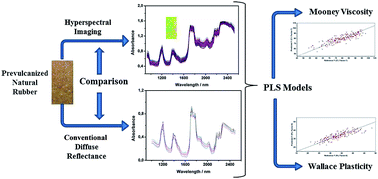Comparing near-infrared conventional diffuse reflectance spectroscopy and hyperspectral imaging for determination of the bulk properties of solid samples by multivariate regression: determination of Mooney viscosity and plasticity indices of natural rubber
Abstract
Conventional reflectance spectroscopy (NIRS) and hyperspectral imaging (HI) in the near-infrared region (1000–2500 nm) are evaluated and compared, using, as the case study, the determination of relevant properties related to the quality of natural rubber. Mooney viscosity (MV) and plasticity indices (PI) (PI0 – original plasticity, PI30 – plasticity after accelerated aging, and PRI – the plasticity retention index after accelerated aging) of rubber were determined using multivariate regression models. Two hundred and eighty six samples of rubber were measured using conventional and hyperspectral near-infrared imaging reflectance instruments in the range of 1000–2500 nm. The sample set was split into regression (n = 191) and external validation (n = 95) sub-sets. Three instruments were employed for data acquisition: a line scanning hyperspectral camera and two conventional FT-NIR spectrometers. Sample heterogeneity was evaluated using hyperspectral images obtained with a resolution of 150 × 150 μm and principal component analysis. The probed sample area (5 cm2; 24 000 pixels) to achieve representativeness was found to be equivalent to the average of 6 spectra for a 1 cm diameter probing circular window of one FT-NIR instrument. The other spectrophotometer can probe the whole sample in only one measurement. The results show that the rubber properties can be determined with very similar accuracy and precision by Partial Least Square (PLS) regression models regardless of whether HI-NIR or conventional FT-NIR produce the spectral datasets. The best Root Mean Square Errors of Prediction (RMSEPs) of external validation for MV, PI0, PI30, and PRI were 4.3, 1.8, 3.4, and 5.3%, respectively. Though the quantitative results provided by the three instruments can be considered equivalent, the hyperspectral imaging instrument presents a number of advantages, being about 6 times faster than conventional bulk spectrometers, producing robust spectral data by ensuring sample representativeness, and minimizing the effect of the presence of contaminants.

- This article is part of the themed collection: Analytical Sciences in Brazil

 Please wait while we load your content...
Please wait while we load your content...